
A quiver is a container for holding arrows, bolts, or darts. It can be carried on an archer's body, the bow, or the ground, depending on the type of shooting and the archer's personal preference. Quivers were traditionally made of leather, wood, furs, and other natural materials, but are now often made of metal or plastic.

An arrow is a fin-stabilized projectile that is launched via a bow, and usually consists of a long straight stiff shaft with stabilizers called fletchings, as well as a weighty arrowhead attached to the front end, and a slot at the rear end called the nock for engaging the bowstring. The use of bows and arrows by humans predates recorded history and is common to most cultures. A craftsman who makes arrows is a fletcher, and one that makes arrowheads is an arrowsmith.

In modern archery, a compound bow is a bow that uses a levering system, usually of cables and pulleys, to bend the limbs.

The bow and arrow is a ranged weapon system consisting of an elastic launching device (bow) and long-shafted projectiles (arrows).
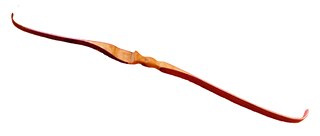
In archery, the shape of the bow is usually taken to be the view from the side. It is the product of the complex relationship of material stresses, designed by a bowyer. This shape, viewing the limbs, is designed to take into account the construction materials, the performance required, and the intended use of the bow.
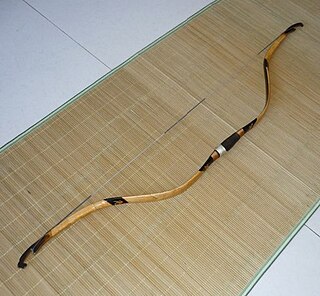
A composite bow is a traditional bow made from horn, wood, and sinew laminated together, cf. laminated bow. The horn is on the belly, facing the archer, and sinew on the outer side of a wooden core. When the bow is drawn, the sinew and horn store more energy than wood for the same length of bow. The strength can be made similar to that of all-wood "self" bows, with similar draw-length and therefore a similar amount of energy delivered to the arrow from a much shorter bow. However, making a composite bow requires more varieties of material than a self bow, its construction takes much more time, and the finished bow is more sensitive to moisture.
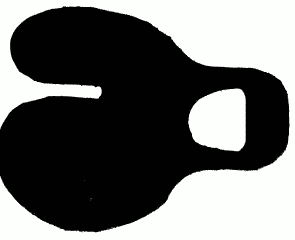
In archery, a finger tab or archer tab is a small leather or synthetic patch that protects an archer's fingers from the bowstring. It is strapped or otherwise attached to an archer's hand. In summertime, tabs are far more comfortable than gloves and can more conveniently use thicker material. They are also less expensive and easier to fit, and are the normal finger-protection used with bows.
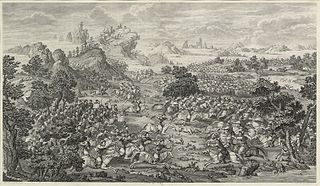
The Mongol bow is a type of recurved composite bow used in Mongolia. "Mongol bow" can refer to two types of bow. From the 17th century onward, most of the traditional bows in Mongolia were replaced with the similar Manchu bow which is primarily distinguished by larger siyahs and the presence of prominent string bridges.

Bowfishing is a method of fishing that uses specialized archery equipment to shoot and retrieve fish. Fish are shot with a barbed arrow that is attached with special line to a reel mounted on the bow. Some freshwater species commonly hunted include common carp, grass carp, bighead carp, alligator gar, and paddlefish. In saltwater, rays and sharks are regularly pursued.
A flatbow is a bow with non-recurved, flat, relatively wide limbs that are approximately rectangular in cross-section. Because the limbs are relatively wide, flatbows will usually narrow and become deeper at the handle, with a rounded, non-bending handle for easier grip. This design differs from that of a longbow, which has rounded limbs that are circular or D shaped in cross-section, and is usually widest at the handle. A flatbow can be just as long as a longbow, but can be very short. Traditional flatbows are usually wooden self bows, though laminated and composite flatbows have been made in ancient and modern times. Modern flatbows commonly use fiberglass.
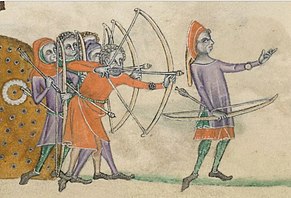
A longbow is a type of bow that is tall – roughly equal to the height of the user – allowing the archer a fairly long draw. A longbow is not significantly recurved. Its limbs are relatively narrow so that they are circular or D-shaped in cross section. Flatbows can be just as long; the difference is that, in cross-section, a flatbow has limbs that are approximately rectangular.
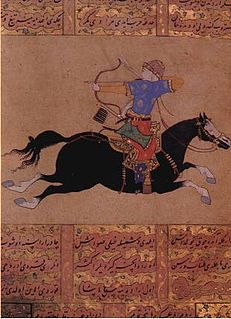
Turkish archery is a tradition of archery which became highly developed in the Ottoman Empire, although its origins date back to the Eurasian Steppe in the second millennium BC.

The archer's paradox is the phenomenon of an arrow traveling in the direction it is pointed at full draw, when it seems that the arrow would have to pass through the starting position it was in before being drawn, where it was pointed to the side of the target. The bending of the arrow when released is the explanation for why the paradox occurs and should not be confused with the paradox itself. Flexing of the arrow when shot from a modern 'centre shot' bow is still present and is caused by a variety of factors, mainly the way the string is deflected from the fingers as the arrow is released.

A bowstring joins the two ends of the bow stave and launches the arrow. Desirable properties include light weight, strength, resistance to abrasion, and resistance to water. Mass has most effect at the center of the string; one gram (0.035 oz) of extra mass in the middle of the string slows the arrow about as much as 3.5 grams (0.12 oz) at the ends.
A bow draw is the method used to draw a bow. Currently, the most common method in modern target archery is the Mediterranean draw, long the usual method in European archery. Other methods include the pinch draw and the Mongolian or "thumb" draw. In traditional archery practice outside of Western Europe the variations of the thumb draw are by far the most dominant draw types with the Mediterranean draw restricted to Olympic style target shooting.
This is a list of archery terms, including both the equipment and the practice. A brief description for each word or phrase is also included.
In archery, a release aid, mechanical release, or release is a device that helps to fire arrows more precisely, by using a trigger to release the bowstring, rather than the archer's fingers. It is used to make the release of the bowstring quicker and reducing the amount of torque put onto the bowstring from the archer's fingers.
Hoyt Archery is an American manufacturer of recurve and compound bows located in Salt Lake City, Utah. Most notable for their competition recurve bows, which are featured prominently in the Olympics; every gold medalist in individual archery at the 2012 Summer Olympics shot a Hoyt recurve. Hoyt is owned by Jas. D. Easton, Inc..















